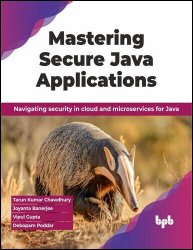 Название: Mastering Secure Java Applications: Navigating security in cloud and microservices for Java
Название: Mastering Secure Java Applications: Navigating security in cloud and microservices for JavaАвтор: Tarun Kumar Chawdhury, Joyanta Banerjee, Vipul Gupta, Debopam Poddar
Издательство: BPB Publications
Год: 2024
Страниц: 784
Язык: английский
Формат: pdf, epub
Размер: 15.8 MB
Elevate your Java security skills for the modern cloud era.
Key Features:
- Understanding Zero-Trust security model for Java.
- Practical cloud security strategies for developers.
- Hands-on guidance for secure Java application development.
Description:
This book offers a comprehensive guide to implementing Zero-Trust security principles, cloud-based defenses, and robust application development practices. Through practical examples and expert advice, readers will gain the skills needed to design and develop secure Java applications that easily can tackle today's cyber threats.
It builds focus on securing your source code through analysis, vulnerability detection, and automation. It also ensures the safety of your runtime environment for managing traffic and enables multi-factor authentication. While addressing data security concerns with encryption, anonymization, and cloud-based solutions, it also uses tools like OpenTelemetry for real-time threat detection. It manages sensitive information securely with Vault integration and explores passwordless authentication. Reference architectures, secure coding patterns, and automation practices are also provided to aid implementation.
By the end of this book, you'll be well-equipped to build secure Java applications with confidence and deliver applications that are robust, reliable, and compliant.
What you will learn:
- Implement Zero-Trust principles in Java applications.
- Secure Java apps in cloud environments like AWS, GCP, and Azure.
- Develop applications with security best practices from the ground up.
- Understand and mitigate common security vulnerabilities in Java.
- Apply modern security tools and techniques in Java development.
Chapter 1: Secure Design Principles for Java Applications - This chapter introduces the critical transition from traditional n-tier architectures to cloud-native and microservices designs in Java application development. It emphasizes the adoption of the Zero-Trust security model as a response to evolving security threats, using the Log4j vulnerability as a case study to illustrate the necessity of authenticating every request and adopting a defense-in-depth approach. The chapter lays the foundation for securing Java applications through practical application of Zero-Trust principles, aiming to equip developers with strategies to mitigate risks associated with modern software development environments.
Chapter 2: Analyzing and Securing Source This chapter delves into the composition and significance of Java application source code, highlighting its incorporation of interfaces, classes, and external libraries. It underscores the reusability advantage facilitated by Java's open-source nature, allowing developers to concentrate on core functionalities and streamline software development. Security implications are emphasized, stressing the need for developers to comprehend both their own code and external dependencies to ensure a robust and secure application.
Chapter 3: Securing Java This chapter delves into the diverse strategies for fortifying the runtime environment of Java applications. It discusses foundational methods for enhancing application security, encompassing the consistent application of patches provided for the Java version, implementation of robust authentication and authorization mechanisms, adoption of secure coding practices, and the establishment of secure data transmission protocols across networks.
...
Chapter 10: Secure Coding Tips and Practices - In this chapter, we delve into the heart of secure coding, empowering you to write Java that is robust against evolving threats. This is not just a theoretical exercise; we will dive deep into practical implementation, guiding you through secure coding practices for each layer of a JavaEE application. You will explore the core principles of secure coding, understanding the philosophy behind writing code that prioritizes security. We will also discuss why secure coding matters, delving into the crucial role it plays in safeguarding your applications and user data.
Who this book is for:
This book is ideal for Java developers and software architects seeking to enhance their security expertise, particularly in cloud environments.
Скачать Mastering Secure Java Applications: Navigating security in cloud and microservices for Java